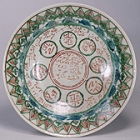Japanese Gallery (Honkan) Room 14
October 20, 2009 (Tue) - December 20, 2009 (Sun)
Toward the end of the Ming dynasty, from the 16th to the first half of the 17th century, porcelain wares decorated with bold designs rendered freely in red and green overglaze enamels were produced in China and exported to Southeast Asia and Japan in great numbers. These wares are known as gosu-akae in Japanese. Gosu-akae designs are characterized by lively brushwork and dominated by a distinctive flaming red, which lends them a unique appeal.
In Japanese, the word "gosu" refers broadly to the south of China, evidencing the fact that whilst the wares were known to have been produced in this region, the specific location was originally unclear. "Akae," meanwhile, gestures to the painted designs, with "aka" meaning "red" and "e" meaning "design" or "picture." In the West, as the wares were shipped from Shantou (formerly known in English as "Swatow") in the north of Guangdong province, they came to be known as Swatow wares.
In the 1990s, the Zhangzhou area of southern Fujian province was identified as the source of these wares, and an archaeological survey of the former kiln sites undertaken jointly by Japan and China has helped research in this area to progress significantly.
Along with gosu-akae, the Zhangzhou kilns produced a wide variety of porcelain wares, including those known in Japan as gosu-aoe, primarily featuring blue ("ao") designs; gosu-sometsuke, with underglaze designs in indigo blue; and mochibana-de, with designs rendered in opaque white glaze on a ground of brown or blue glaze. This exhibition introduces gosu-akae wares which were prized as incense containers and confectionery dishes in tea ceremony settings in Japan, in addition to late Edo-period Kyoto-ware reproductions of gosu-akae porcelain, thus illustrating the deep connection between gosu-akae and Japanese culture.

